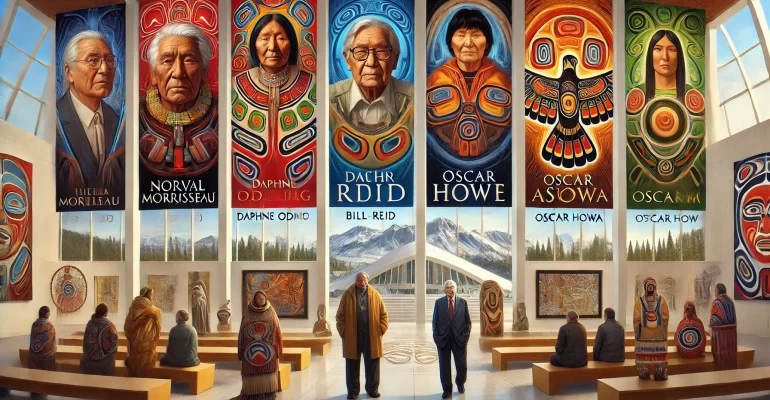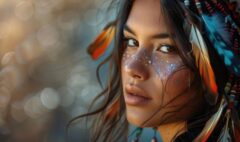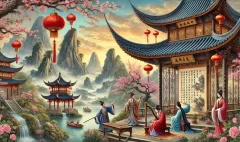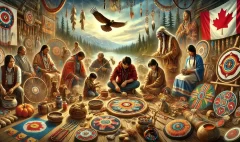Five Incredible Indigenous Artists Who Have Passed Away
Five Incredible Indigenous Artists Who Have Passed Away
In this blog post, we celebrate the lives and works of five incredible Indigenous artists who have passed away. These artists—Norval Morrisseau, Daphne Odjig, Bill Reid, Oscar Howe, and Pitseolak Ashoona—have made significant contributions to the art world. Their unique styles and powerful messages continue to inspire and influence both Indigenous and non-Indigenous communities around the globe. Join us as we explore their backgrounds, artistic journeys, and lasting legacies.
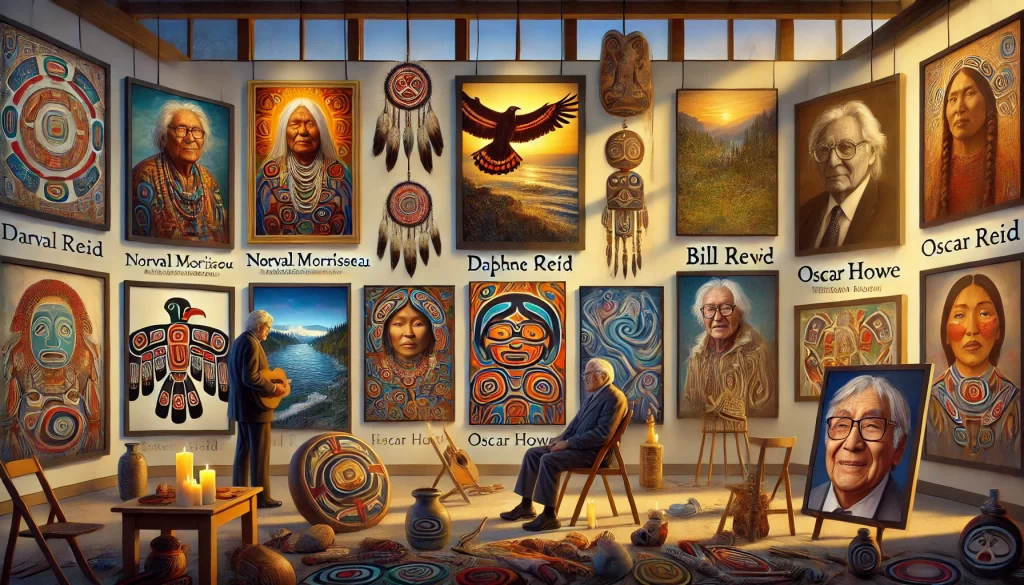
Norval Morrisseau: The “Picasso of the North”
- Early Life and Background
Norval Morrisseau, also known as Copper Thunderbird, was born on March 14, 1932, in Sandy Lake, Ontario. As a member of the Anishinaabe (Ojibwe) people, Morrisseau’s early life was deeply influenced by his cultural heritage. Raised by his maternal grandparents, he learned traditional Anishinaabe ways and spirituality, which would later become central themes in his art.
- Artistic Career
Morrisseau developed a unique style that combined Indigenous iconography and spiritual symbolism with modern artistic techniques. His art is characterized by bold colors, thick black outlines, and x-ray-like images of animals, people, and spiritual beings. Through his work, he explored themes of spirituality, mythology, and the natural world, often depicting the interconnectedness of all life forms.
- Key Achievements
Morrisseau’s contributions to art were groundbreaking. He was the first Indigenous artist to have a solo exhibition at the National Gallery of Canada in 1962 and received numerous accolades, including the Order of Canada in 1978. He founded the Woodland School of Art, which has influenced many Indigenous artists in Canada and beyond.
- Personal Life and Challenges
Despite his success, Morrisseau faced numerous challenges, including poverty, alcoholism, and periods of homelessness. He was a deeply spiritual person, and his art often reflected his visions and the teachings of his culture. In his later years, Morrisseau suffered from Parkinson’s disease, which affected his ability to paint.
- Notable Works
Among his famous works are “Man Changing into Thunderbird,” symbolizing transformation and spiritual power, and several self-portraits that reveal his personal journey and beliefs.
- Controversies and Legacy
Morrisseau’s work has been subject to widespread forgery, leading to legal battles over the authenticity of many pieces attributed to him. Despite these challenges, his legacy as a pioneer of Indigenous art endures, and his work continues to be celebrated for its innovative style and spiritual depth.
Daphne Odjig: Bridging Indigenous Traditions and Modern Art
- Early Life
Daphne Odjig was born on September 11, 1919, in Wikwemikong, Ontario. She was of Potawatomi and Odawa heritage and grew up on Manitoulin Island. Odjig’s parents and grandparents instilled in her a deep appreciation for her Indigenous culture and traditions.
- Artistic Career
Odjig is known for her unique style that blends Indigenous art traditions with modern techniques. Her work often focuses on Indigenous history, culture, and social issues, depicting community life, legends, and the struggles of Indigenous people. She worked with various mediums, including painting, printmaking, and drawing.
- Key Achievements
Odjig was the first Indigenous woman to have a solo exhibition at the National Gallery of Canada in 1974. She received numerous honors, including the Order of Canada in 1986 and the Governor General’s Award in Visual and Media Arts in 2007. As one of the five incredible Indigenous artists who have passed away, she also co-founded the Professional Native Indian Artists Inc., known as the “Indian Group of Seven,” to support Indigenous artists.
- Personal Life
Odjig was married twice, first to Paul Somerville and later to Chester Beavon. She moved to various places, including British Columbia, where she continued her art and community work.
- Notable Works
Some of her notable works include “The Indian in Transition,” a mural depicting the impact of European colonization on Indigenous people, and “The Sioux Massacre,” which reflects on historical events and their lasting effects.
- Influence and Legacy
Daphne Odjig’s art brought Indigenous stories and perspectives to a wider audience. She helped pave the way for future Indigenous artists and made a lasting impact on Canadian art and culture. Her work is celebrated for its beauty, storytelling, and powerful messages about Indigenous life and history.
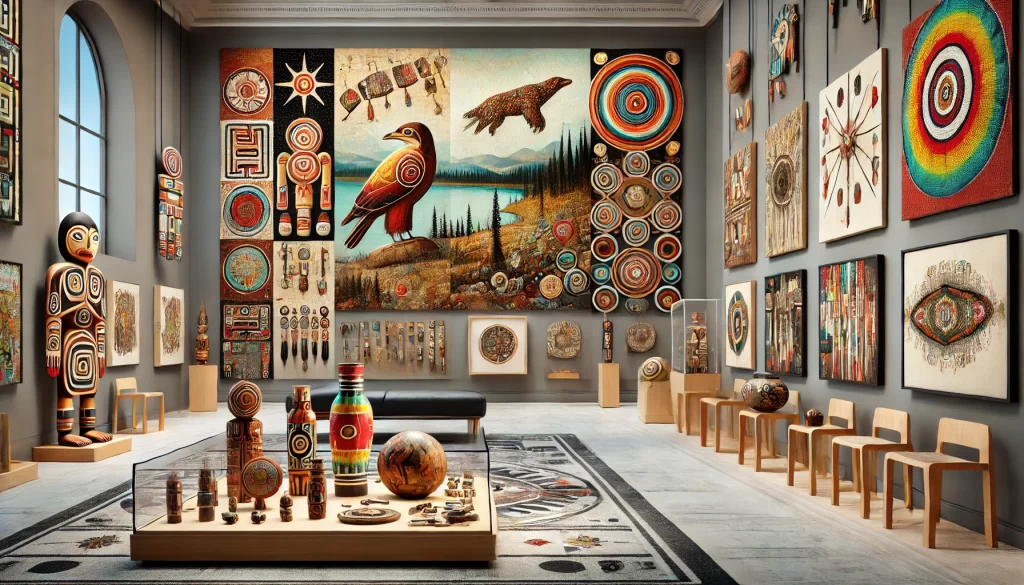
Bill Reid: Master of Haida Art
- Early Life and Background
Bill Reid, a Canadian artist of Haida descent, is renowned for his masterful works that bridge traditional Haida art and contemporary forms. His contributions to art and culture have left a profound impact, making him one of the most celebrated Indigenous artists in Canada.
- Birth and Heritage
Bill Reid was born on January 12, 1920, in Victoria, British Columbia. He was of Haida, Scottish, and German descent. His maternal grandfather was a Haida carver, which influenced Reid’s early interest in Haida art and culture.
- Education and Early Career
Reid initially worked as a radio announcer and studied jewelry making in Toronto. His formal education in European jewelry techniques later played a crucial role in his development as an artist.
- Artistic Career; Return to Haida Roots
In the 1950s, Reid began to explore his Haida heritage more deeply. He studied traditional Haida art and techniques, learning from the works of renowned Haida artist Charles Edenshaw. This period marked the beginning of Reid’s dedication to revitalizing Haida art.
- Signature Style
Reid’s work is characterized by intricate detail, elegant form, and a deep respect for Haida traditions. He skillfully blended traditional Haida design elements with contemporary materials and methods. His works include jewelry, sculptures, prints, and monumental carvings.
- Notable Works
Some of Reid’s most famous pieces include:
- The Raven and the First Men: A monumental sculpture depicting a Haida creation myth, housed at the Museum of Anthropology at the University of British Columbia.
- The Spirit of Haida Gwaii: A massive bronze sculpture of a Haida canoe, displayed at the Canadian Embassy in Washington, D.C., and the Vancouver International Airport.
- Haida Gwaii: Another significant work showcasing Haida culture and mythology.
- Key Achievements; Recognition and Awards
Bill Reid received numerous awards and honors throughout his career, including:
Order of Canada: Recognized for his contributions to Canadian art and culture.
Governor General’s Award: For Visual and Media Arts.
National Aboriginal Achievement Award: For his significant impact on Indigenous arts.
- Cultural Impact
Reid played a crucial role in the renaissance of Haida art in the mid-20th century. His works have been instrumental in bringing Haida culture to international attention and have inspired many Indigenous artists.
- Personal Life; Health and Legacy
In his later years, Reid struggled with Parkinson’s disease, which limited his ability to work with his hands. Despite this, he continued to create art with the help of assistants and remained active in the art community until his passing on March 13, 1998.
- Influence
Bill Reid’s legacy is profound. He is remembered not only for his artistic mastery but also for his role in preserving and promoting Haida culture. His works are displayed in museums and public spaces worldwide, continuing to inspire and educate people about the richness of Haida art and traditions.
Oscar Howe: Modernist Visionary of Yanktonai Dakota Art
- Early Life and Background; Birth and Heritage
Oscar Howe was born on May 13, 1915, in Joe Creek, South Dakota, on the Crow Creek Indian Reservation. He was a member of the Yanktonai Dakota tribe. Howe’s early life was deeply rooted in his cultural heritage, which profoundly influenced his artistic journey. As one of the five incredible Indigenous artists who have passed away, Howe’s legacy continues to inspire and shape the world of art today.
- Education and Early Career
Howe showed a keen interest in art from a young age, attending the Santa Fe Indian School where he studied under Dorothy Dunn. He later earned a Bachelor of Fine Arts from Dakota Wesleyan University and a Master of Fine Arts from the University of Oklahoma. His education blended traditional Indigenous techniques with modernist art principles.
- Artistic Career; Unique Style
Oscar Howe developed a unique style that merged traditional Yanktonai Dakota themes with modernist abstraction. His work is characterized by dynamic compositions, vibrant colors, and geometric forms, often depicting scenes from Dakota history and mythology.
- Notable Works
Some of Howe’s most notable works include:
“Fighting Bucks”: A powerful depiction of two warriors in combat, showcasing Howe’s dynamic style.
“Umine Dance”: Capturing the energy and spirit of a traditional Dakota dance.
“Indian Christ”: A poignant piece reflecting the intersection of Indigenous spirituality and Christianity.
- Key Achievements; Recognition and Awards
Oscar Howe received numerous accolades throughout his career, including:
Philbrook Art Center Grand Award: For his significant contributions to Native American art.
South Dakota Governor’s Award: Recognizing his impact on the arts in South Dakota.
- Cultural Impact
Howe’s innovative approach challenged and expanded the boundaries of Native American art, paving the way for future generations of Indigenous artists. His work is celebrated for its boldness and cultural depth, bridging traditional and contemporary art forms.
- Personal Life; Legacy
Oscar Howe passed away on October 7, 1983. His legacy continues to inspire and influence artists worldwide. He is remembered for his groundbreaking contributions to Native American art and his role in advocating for greater recognition of Indigenous artists.
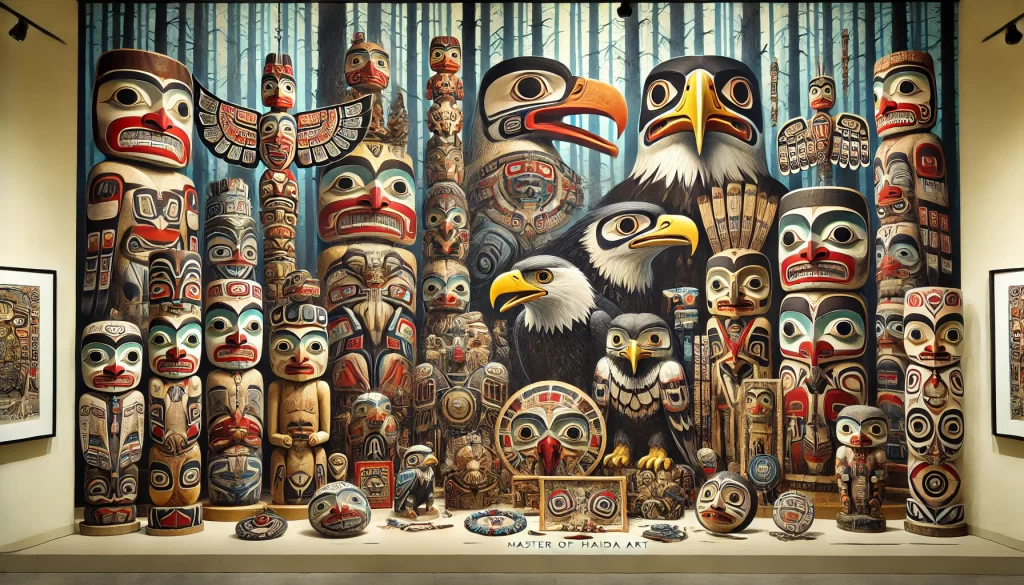
Pitseolak Ashoona: Celebrating Inuit Life through Art
- Early Life and Background; Birth and Heritage
Pitseolak Ashoona was born in 1904 near Cape Dorset, Nunavut, Canada. She was an Inuit artist whose early life was marked by traditional nomadic living. Her experiences growing up in the Arctic profoundly influenced her artistic vision.
- Early Life
Pitseolak married Ashoona, a hunter, and they had 17 children, many of whom became artists. Her life on the land, practicing traditional Inuit ways, provided a rich source of inspiration for her art.
- Artistic Career; Artistic Development
Pitseolak Ashoona began creating art later in life, encouraged by James Houston, an artist and promoter of Inuit art. She became a prolific artist, known for her drawings and prints that vividly depict Inuit life, mythology, and the Arctic environment.
- Notable Works
Some of her notable works include:
“Sea Goddess”: An intricate drawing capturing the mythical figure of Sedna, the Inuit sea goddess.
“Taleelayu”: Illustrating the life and culture of Inuit people with rich detail and color.
“Mother’s Little Helper”: A charming depiction of daily life and family bonds within Inuit culture.
- Key Achievements; Recognition and Awards
Pitseolak Ashoona’s work received widespread acclaim, earning her numerous honors, including:
Order of Canada: For her contributions to Canadian art and culture.
Lifetime Achievement Award from the National Aboriginal Achievement Foundation: Recognizing her impact on Inuit art.
- Cultural Impact
Pitseolak Ashoona is celebrated for her role in documenting and preserving Inuit culture through her art. Her works provide valuable insights into Inuit traditions and daily life, contributing significantly to the recognition of Inuit art on the global stage.
- Personal Life; Legacy
Pitseolak Ashoona passed away on May 28, 1983. Her legacy endures through her extensive body of work, which continues to be exhibited and admired worldwide. She is remembered as a pioneering figure in Inuit art, whose vivid portrayals of Arctic life remain influential and cherished.
Conclusion
The legacies of Norval Morrisseau, Daphne Odjig, Bill Reid, Oscar Howe, and Pitseolak Ashoona continue to impact the art world profoundly. These five incredible Indigenous artists who have passed away have paved the way for future generations of Indigenous artists, ensuring that their rich cultures and histories are celebrated and remembered. Through their art, they have told stories, shared their heritage, and brought greater understanding and appreciation of Indigenous peoples to a wider audience. Their works remain a testament to their talent, resilience, and the enduring power of art.

